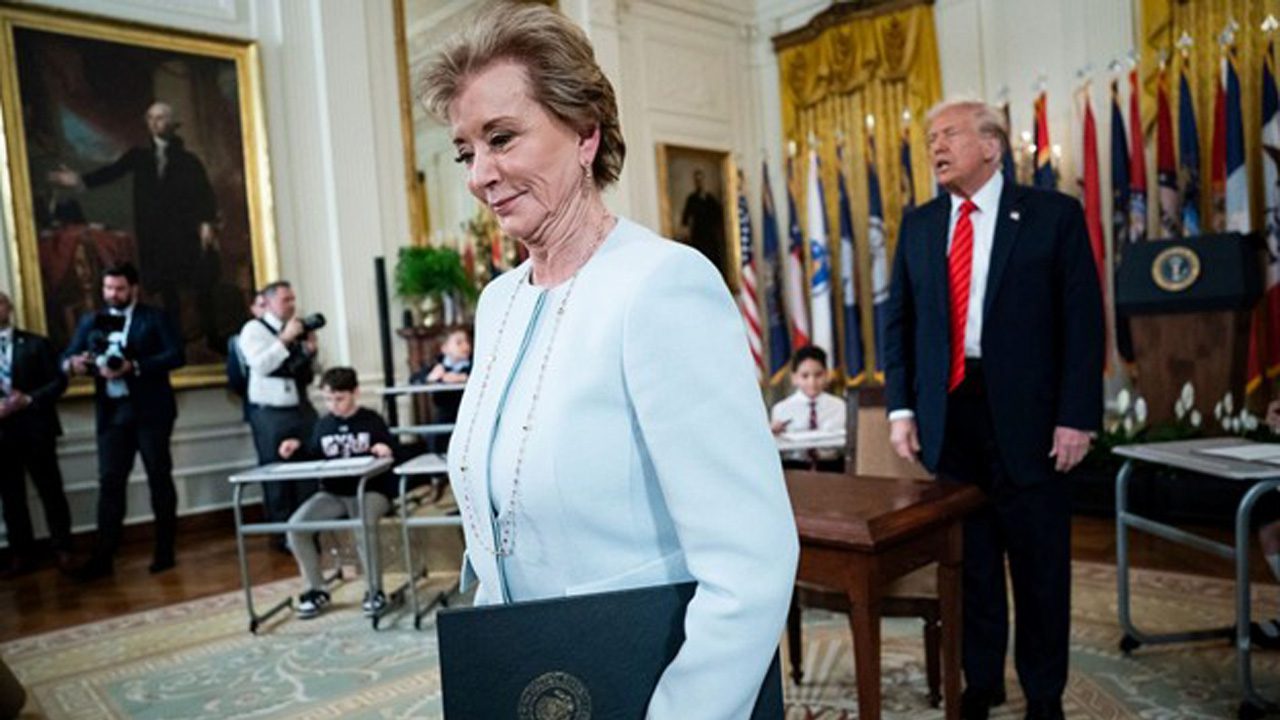
Close to $3 Billion in Pandemic Funds in Jeopardy as Education Department Abruptly Halts Payments
The 74 | By Linda Jacobson |
Officials labeled even extensions agreed upon during Trump’s tenure ‘unreasonable’ and cited what it called examples of ‘misuse.’
States risk losing close to $3 billion in remaining COVID relief funds after U.S. Education Secretary Linda McMahon announced Friday that they’ll no longer be reimbursed for pandemic-related costs.
As recently as February, the department told 41 states and the District of Columbia they had another year to spend down the rest of the $122 billion for schools awarded in the 2021 American Rescue Plan. Among the biggest potential losers from McMahon’s move are Texas and Pennsylvania, which have well over $200 million in unspent funds, according to a department spreadsheet shared by a source close to the department. The source asked not to be named to protect former staff members from retaliation. Several more states, including Ohio, New York and Tennessee, have over $100 million left over.
In a letter to state chiefs, Education Secretary Linda McMahon called it “unreasonable” for them to rely on those earlier decisions. She said she might reconsider if states can make a stronger case for how their projects continue to address COVID’s impact.
“We’ve seen a lot of receipts and reimbursement requests coming in that just aren’t aligned with what students need in this moment,” a senior department official told The 74. The official asked to remain anonymous to speak freely about the department’s decision. The administration wants to “make sure that funds are still being spent to fix student learning loss.”
The official cited a $1 million window replacement and an order of “glow balls” as examples, but declined to name the district that ordered the balls and offered no additional information on their price or how schools planned to use them.

Protesters demonstrated outside the U.S. Department of Education to oppose the Trump administration’s actions to fire staff and eliminate the agency.
The department, however, will pay any invoices that were submitted before Friday at 5 p.m. Most of those are tied to extensions from the second COVID relief package, which included $58 billion in education spending, the official said. The deadline to spend those funds was Monday.
In total, Congress approved about $200 billion in school relief funds. While states and districts spent the vast majority — about 97% — by the end of January, they asked for more time to deal with supply chain delays, labor shortages and the fact that student performance has largely not recovered from the pandemic. McMahon’s action, some experts say, should not have come as a complete shock given criticisms by many Republicans that districts failed to make the most of the unprecedented infusion of money.
But the action leaves states and districts in the lurch, having spent millions of dollars of their own funds and signed contracts with vendors tied to the promise of reimbursement from the education department.
Some leaders are pleading with McMahon to reconsider.
“This abrupt change in course will slow efforts and, in many cases, grind them to a halt,” Maryland state Superintendent Carey Wright said in a statement. Her state risks losing over $400 million in funding for K-12 schools. The funds, she said, are paying for science of reading materials, teacher training and a variety of facility upgrades. “State and local budgets will be impacted. Maryland students deserve for the federal government to uphold its agreements.”
McMahon said the extensions offered by both the Biden and Trump administrations were merely “a matter of administrative grace,” and that the department has the authority to hold states to the original spending deadline in the law — Jan. 28. But as with other decisions the department has made to cut off funding Congress already approved, Friday’s announcement is likely to spark legal challenges.
“We are exploring all legal options at this time given the severity of this action,” Joshua Michael, president of the Maryland State Board of Education, told reporters Monday. The funding, he said, is supporting ongoing tutoring programs. “That tutor will probably not be there next week.”
‘Unpaid invoices’
Other states say the department’s decision will have an immediate impact on students. Illinois, for example, is using its remaining relief funds on transportation to school for homeless students, afterschool tutoring and technology for students with disabilities, said Jackie Matthews, spokeswoman for the Illinois State Board of Education.
Last week, the state was still waiting on a $720,000 reimbursement from the department and had yet to submit another $8 million in expenses.
“The unpaid invoices continue to stack up,” she said.
In Tennessee, education officials received an extension for nearly $131 million for expenditures like tutoring, nursing services and computers, according to state education department spokesman Brian Blackley. Staff members, he said, were preparing to submit a reimbursement request.
The American Rescue Plan — the third and largest round of funding — also included $800 million earmarked for homeless students. Extensions on those funds are paying for summer learning programs, mental health services and “navigators” who help homeless families with housing, food and transportation needs, said Barbara Duffield, executive director of SchoolHouse Connection, which advocates for homeless students.
An Education Department report released just before former Education Secretary Miguel Cardona left office showed the program was effective at helping districts identify homeless students and reduce chronic absenteeism.
Canceling the extension, Duffield said, “pulls the rug out from underneath school district efforts to stabilize and support homeless children and youth.”
David DeSchryver, senior vice president at Whiteboard Advisors, a consulting firm, said states should not have been caught off guard by the department’s latest move, but emphasized that the “door is still open” for further extensions.
“This is another invitation for state and local leaders to tell better stories about the impact of federal funding on their schools and communities,” he said.
‘The people’s bank account’
Districts began asking the department for extensions back in 2022 when supply chain delays and escalating construction costs prohibited them from finishing projects on time.
To get reimbursed, the department required states with extensions to submit funding requests describing how the expenditures related to the pandemic. The department didn’t ask for purchase orders or contracts, but told states to keep those on hand if needed later.
The department tightened the process in February, requiring states to submit detailed receipts for every purchase in order to get reimbursed. Then on March 11, McMahon fired all 16 staff members in the office responsible for processing payments.
By that point, state education leaders had grown impatient. On March 15, a Pennsylvania official emailed the department, saying “I’m reaching out again to find out the status of these approvals,” according to a copy of the message shared with The 74.
“It makes me incredibly angry,” said Laura Jimenez, a Biden administration appointee who led the relief payment office until January. “We very carefully administered $200 billion, and they’re completely destroying that with the last couple of billion.”
In a statement Friday, department spokeswoman Madi Biedermann said it was “past time for the money to be returned to the people’s bank account” and referred to “numerous documented examples of misuse” of relief funds. She declined to offer examples.
The GOP has consistently criticized how districts used the money, focusing on expenditures that appeared removed from helping students recover lost learning, like athletic fields and weight rooms. They argue that sharp declines in achievement and spending on what they dismiss as “woke” initiatives like LGBTQ-inclusive efforts and social-emotional learning offer evidence of misspent funds.
Georgetown University school finance expert Marguerite Roza pointed to “eyebrow-raising spending decisions,” like contracts to family members, massage chairs in a teachers lounge in Montana and six-figure salaries for district leaders in Stockton, California.
But compared to other COVID aid, like the Paycheck Protection Program — which lost over $60 billion from theft — there’s been little evidence of actual fraud in school relief funds, Roza said. The department took steps to prevent it. In 2023, the Office of the Inspector General found that the agency had taken “significant actions” to improve monitoring of the funds.
Even so, researchers largely agree that despite many bright spots, districts missed a once-in-a-lifetime opportunity to prioritize academic recovery in the aftermath of the COVID emergency. Tutoring is one example. While most districts offered it — and still are — they didn’t always use methods backed by research, experts say.
Some districts initially demonstrated a lack of urgency and were slow to spend the money, according to a tracker Roza created to follow relief funds. Then they had to pick up the pace as deadlines approached. Many went on a hiring spree, quickly adding classroom aides, counselors and other support staff, but Roza’s analysis showed that those positions weren’t always targeted to schools that needed them most.
“You don’t want to force school systems to spend money more quickly than they are wanting to,” said Dan Goldhaber, director of the Center for Analysis of Longitudinal Data in Education Research.
His research shows that while the money contributed to significant recovery in math, students continue to lose ground in reading. But as a one-time school board member, he sympathizes with districts that pushed to spread funds out as long as possible.
“That rush to get a lot of money out the door,” he said, “may have led to some of it not being spent very well.”





